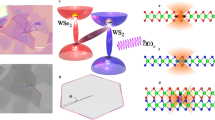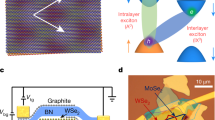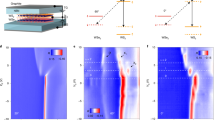Abstract
Recent advances in the isolation and stacking of monolayers of van der Waals materials have provided approaches for the preparation of quantum materials in the ultimate two-dimensional limit1,2. In van der Waals heterostructures formed by stacking two monolayer semiconductors, lattice mismatch or rotational misalignment introduces an in-plane moiré superlattice3. It is widely recognized that the moiré superlattice can modulate the electronic band structure of the material and lead to transport properties such as unconventional superconductivity4 and insulating behaviour driven by correlations5,6,7; however, the influence of the moiré superlattice on optical properties has not been investigated experimentally. Here we report the observation of multiple interlayer exciton resonances with either positive or negative circularly polarized emission in a molybdenum diselenide/tungsten diselenide (MoSe2/WSe2) heterobilayer with a small twist angle. We attribute these resonances to excitonic ground and excited states confined within the moiré potential. This interpretation is supported by recombination dynamics and by the dependence of these interlayer exciton resonances on twist angle and temperature. These results suggest the feasibility of engineering artificial excitonic crystals using van der Waals heterostructures for nanophotonics and quantum information applications.
This is a preview of subscription content, access via your institution
Access options
Access Nature and 54 other Nature Portfolio journals
Get Nature+, our best-value online-access subscription
$29.99 / 30 days
cancel any time
Subscribe to this journal
Receive 51 print issues and online access
$199.00 per year
only $3.90 per issue
Buy this article
- Purchase on Springer Link
- Instant access to full article PDF
Prices may be subject to local taxes which are calculated during checkout




Similar content being viewed by others
Data availability
The data that support the findings of this study are available from the corresponding author upon reasonable request.
References
Li, M.-Y., Chen, C.-H., Shi, Y. & Li, L.-J. Heterostructures based on two-dimensional layered materials and their potential applications. Mater. Today 19, 322–335 (2016).
Liu, Y. et al. Van der Waals heterostructures and devices. Nat. Rev. Mater. 1, 16042 (2016).
Zhang, C. et al. Interlayer couplings, Moiré patterns, and 2D electronic superlattices in MoS2/WSe2 hetero-bilayers. Sci. Adv. 3, e1601459 (2017).
Cao, Y. et al. Unconventional superconductivity in magic-angle graphene superlattices. Nature 556, 43–50 (2018).
Hunt, B. et al. Massive Dirac fermions and Hofstadter butterfly in a van der Waals heterostructure. Science 340, 1427–1430 (2013).
Dean, C. R. et al. Hofstadter’s butterfly and the fractal quantum Hall effect in moiré superlattices. Nature 497, 598–602 (2013).
Kim, K. et al. Tunable moiré bands and strong correlations in small-twist-angle bilayer graphene. Proc. Natl Acad. Sci. USA 114, 3364–3369 (2017).
Hsu, W.-T. et al. Negative circular polarization emissions from WSe2/MoSe2 commensurate heterobilayers. Nat. Commun. 9, 1356 (2018).
van der Zande, A. M. et al. Tailoring the electronic structure in bilayer molybdenum disulfide via interlayer twist. Nano Lett. 14, 3869–3875 (2014).
Kang, J., Tongay, S., Zhou, J., Li, J. & Wu, J. Band offsets and heterostructures of two-dimensional semiconductors. Appl. Phys. Lett. 102, 012111 (2013).
Kośmider, K. & Fernández-Rossier, J. Electronic properties of the MoS2-WS2 heterojunction. Phys. Rev. B 87, 075451 (2013).
Chiu, M.-H. et al. Determination of band alignment in the single-layer MoS2/WSe2 heterojunction. Nat. Commun. 6, 7666 (2015).
Hong, X. et al. Ultrafast charge transfer in atomically thin MoS2/WS2 heterostructures. Nat. Nanotechnol. 9, 682–686 (2014).
Rivera, P. et al. Observation of long-lived interlayer excitons in monolayer MoSe2–WSe2 heterostructures. Nat. Commun. 6, 6242 (2015).
Gong, Y. et al. Vertical and in-plane heterostructures from WS2/MoS2 monolayers. Nat. Mater. 13, 1135–1142 (2014).
Wu, F., Lovorn, T. & MacDonald, A. H. Theory of optical absorption by interlayer excitons in transition metal dichalcogenide heterobilayers. Phys. Rev. B 97, 035306 (2018).
Wu, F., Lovorn, T. & MacDonald, A. H. Topological exciton bands in moiré heterojunctions. Phys. Rev. Lett. 118, 147401 (2017).
Yu, H., Liu, G.-B., Tang, J., Xu, X. & Yao, W. Moiré excitons: From programmable quantum emitter arrays to spin-orbit-coupled artificial lattices. Sci. Adv. 3, e1701696 (2017).
Gillen, R. & Maultzsch, J. Interlayer excitons in MoSe2/WSe2 heterostructures from first principles. Phys. Rev. B 97, 165306 (2018).
Yu, H., Wang, Y., Tong, Q., Xu, X. & Yao, W. Anomalous light cones and valley optical selection rules of interlayer excitons in twisted heterobilayers. Phys. Rev. Lett. 115, 187002 (2015).
Andres, C.-G. et al. Deterministic transfer of two-dimensional materials by all-dry viscoelastic stamping. 2D Mater. 1, 011002 (2014).
Philipp, N. et al. Interlayer exciton dynamics in a dichalcogenide monolayer heterostructure. 2D Mater. 4, 025112 (2017).
Nagler, P. et al. Giant magnetic splitting inducing near-unity valley polarization in van der Waals heterostructures. Nat. Commun. 8, 1551 (2017).
Zeng, H., Dai, J., Yao, W., Xiao, D. & Cui, X. Valley polarization in MoS2 monolayers by optical pumping. Nat. Nanotechnol. 7, 490–493 (2012).
Mak, K. F., He, K., Shan, J. & Heinz, T. F. Control of valley polarization in monolayer MoS2 by optical helicity. Nat. Nanotechnol. 7, 494–498 (2012).
Tran, K. et al. Disorder-dependent valley properties in monolayer WSe2. Phys. Rev. B 96, 041302 (2017).
Schaibley, J. R. et al. Directional interlayer spin-valley transfer in two-dimensional heterostructures. Nat. Commun. 7, 13747 (2016).
Torchynska, T. V., Dybiec, M. & Ostapenko, S. Ground and excited state energy trend in InAs/InGaAs quantum dots monitored by scanning photoluminescence spectroscopy. Phys. Rev. B 72, 195341 (2005).
Kunstmann, J. et al. Momentum-space indirect interlayer excitons in transition-metal dichalcogenide van der Waals heterostructures. Nat. Phys. 14, 801–805 (2018).
Nayak, P. K. et al. Probing evolution of twist-angle-dependent interlayer excitons in MoSe2/WSe2 van der Waals heterostructures. ACS Nano 11, 4041–4050 (2017).
Ciarrocchi, A. et al. Polarization switching and electrical control of interlayer excitons in two-dimensional van der Waals heterostructures. Nat. Photonics 13, 131–136 (2018).
Hanbicki, A. T. et al. Double indirect interlayer exciton in a MoSe2/WSe2 van der Waals heterostructure. ACS Nano 12, 4719–4726 (2018).
Wang, Z., Chiu, Y.-H., Honz, K., Mak, K. F. & Shan, J. Electrical tuning of interlayer exciton gases in WSe2 bilayers. Nano Lett. 18, 137–143 (2018).
Kumar, N. et al. Second harmonic microscopy of monolayer MoS2. Phys. Rev. B 87, 161403 (2013).
Malard, L. M., Alencar, T. V., Barboza, A. P. M., Mak, K. F. & de Paula, A. M. Observation of intense second harmonic generation from MoS2 atomic crystals. Phys. Rev. B 87, 201401 (2013).
Wilson, P. T., Jiang, Y., Aktsipetrov, O. A., Mishina, E. D. & Downer, M. C. Frequency-domain interferometric second-harmonic spectroscopy. Opt. Lett. 24, 496–498 (1999).
Kresse, G. & Furthmüller, J. Efficient iterative schemes for ab initio total-energy calculations using a plane-wave basis set. Phys. Rev. B 54, 11169–11186 (1996).
Kresse, G. & Joubert, D. From ultrasoft pseudopotentials to the projector augmented-wave method. Phys. Rev. B 59, 1758–1775 (1999).
Lepetit, L., Chériaux, G. & Joffre, M. Linear techniques of phase measurement by femtosecond spectral interferometry for applications in spectroscopy. J. Opt. Soc. Am. B 12, 2467–2474 (1995).
Veenstra, K. J., Petukhov, A. V., de Boer, A. P. & Rasing, T. Phase-sensitive detection technique for surface nonlinear optics. Phys. Rev. B 58, R16020–R16023 (1998).
Mouri, S. et al. Thermal dissociation of inter-layer excitons in MoS2/MoSe2 hetero-bilayers. Nanoscale 9, 6674–6679 (2017).
Steinhoff, A. et al. Combined influence of Coulomb interaction and polarons on the carrier dynamics in InGaAs quantum dots. Phys. Rev. B 88, 205309 (2013).
Hongyi, Y., Gui-Bin, L. & Wang, Y. Brightened spin-triplet interlayer excitons and optical selection rules in van der Waals heterobilayers. 2D Mater. 5, 035021 (2018).
Wang, Z., Zhao, L., Mak, K. F. & Shan, J. Probing the spin-polarized electronic band structure in monolayer transition metal dichalcogenides by optical spectroscopy. Nano Lett. 17, 740–746 (2017).
Wang, G. et al. In-plane propagation of light in transition metal dichalcogenide monolayers: optical selection rules. Phys. Rev. Lett. 119, 047401 (2017).
Acknowledgements
The work performed by K.T., J.C., A.H.M. and X. Li was primarily supported by the National Science Foundation (NSF) through the Center for Dynamics and Control of Materials, an NSF MRSEC, under Cooperative Agreement DMR-1720595. X. Li also acknowledges partial support from NSF EFMA-1542747 and the Welch Foundation via grant F-1662. The theoretical work by F.W. was supported by the US Department of Energy, Office of Science, Basic Energy Sciences, Materials Sciences and Engineering Division. J.Q acknowledges support from the China Scholarship Council (grant 201706050068). A.H.M., K.K. and E.T. were supported in part by Army Research Office (ARO) grant W911NF-17-1-0312 (MURI). X. Lu and L.Y. are supported by the Air Force Office of Scientific Research (AFOSR) FA9550-17-1-0304 and NSF DMR-1455346. S.K. was financially supported by National Research Foundation of Korea (NRF) grant funded by the South Korean government (2017R1D1B04036381). K.W. and T.T. acknowledge support from the Elemental Strategy Initiative conducted by the MEXT, Japan and JSPS KAKENHI grant JP15K21722. A.R. and S.K.B. acknowledge support from the NASCENT Engineering Research Centre (ERC) funded by NSF grant EEC-1160494. D.A.S acknowledges support from the NSF Graduate Research Fellowship Program. N.L. acknowledges support from NSF CMMI-1351875. The Texas Nanofabrication Facility, where some of the work was carried out, is a member of the National Nanotechnology Coordinated Infrastructure, which is supported by the NSF (grant ECCS-1542159). This work is an official contribution of NIST, which is not subject to copyright in the United States.
Author information
Authors and Affiliations
Contributions
K.T. and G.M. performed the steady-state and time-resolved optical measurements. F.W. and X. Lu performed the calculations. K.T., J.C., J.E., A.Z., M.C., T.T. and K.W. prepared the samples. A.S., K.K., A.R., T.A., J.Q. and D.A.S. assisted with the experiments. K.T., G.M., F.W. and X. Li wrote the manuscript. E.T., S.K.B., N.L., K.L.S., S.K., L.Y., A.H.M. and X. Li supervised the project. All authors discussed the results and commented on the manuscript at all stages.
Corresponding authors
Ethics declarations
Competing interests
The authors declare no competing interests.
Additional information
Publisher’s note: Springer Nature remains neutral with regard to jurisdictional claims in published maps and institutional affiliations.
Extended data figures and tables
Extended Data Fig. 1 Band structure DFT calculation for different stacking types.
a, The three stacking types (\({{\rm{R}}}_{{\rm{h}}}^{{\rm{h}}}\), \({{\rm{R}}}_{{\rm{h}}}^{{\rm{X}}}\) and \({{\rm{R}}}_{{\rm{h}}}^{{\rm{M}}}\)) of the bilayer MoSe2/WSe2 heterostructure and corresponding DFT-calculated band structures. b, Interlayer distance and bandgap of the three stacking types. c, First-principles GW-BSE calculation results for the quasiparticle bandgap and exciton-binding energy of different stacking types.
Extended Data Fig. 2 Second-harmonic generation.
a, Polarization-resolved SHG signal as the sample is rotated in a plane normal to the incident laser. The peaks of the SHG signal correspond to the armchair axes of the crystal. b, Schematics of the phase-resolved SHG setup. c, SHG phase-resolved spectra between the monolayers and the beta barium borate crystal with signals in phase for a twist angle of approximately 0° between the monolayers. d, As in c but with out-of-phase signals for a twist angle of approximately 60°.
Extended Data Fig. 3 Moiré exciton theory model.
a, Moiré reciprocal lattice vectors in the first shell. b, Real-space map of the centre-of-mass wavefunctions for peak 4. c, d, The spatial variation of the σ+ (c) and σ− (d) components of the optical matrix elements.
Extended Data Fig. 4 Thermal decay and recombination dynamics of a heterobilayer with a twist angle of 1°.
a, Temperature dependence of the photoluminescence between 25 K and 70 K. b, Time-resolved photoluminescence dynamics (points) at energies close to the four interlayer exciton transitions labelled in the inset. The solid lines are biexponential fits to the data. The inset shows the emission energy dependence of the fast and slow decay times.
Extended Data Fig. 5 Comparison of photoluminescence between two heterobilayers with slightly different twist angles.
a, Steady-state photoluminescence spectra from the 1° sample (sample 1) and the 2° sample (sample 2). b, Time-resolved photoluminescence dynamics for interlayer exciton emission at 1,320 meV, as indicated by the shaded area in a.
Extended Data Fig. 6 Spectra from different heterobilayer stacking configurations.
Comparison between interlayer exciton resonances from an H-type sample (upper panel) and an R-type sample (lower panel).
Rights and permissions
About this article
Cite this article
Tran, K., Moody, G., Wu, F. et al. Evidence for moiré excitons in van der Waals heterostructures. Nature 567, 71–75 (2019). https://doi.org/10.1038/s41586-019-0975-z
Received:
Accepted:
Published:
Issue Date:
DOI: https://doi.org/10.1038/s41586-019-0975-z
This article is cited by
-
Localisation-to-delocalisation transition of moiré excitons in WSe2/MoSe2 heterostructures
Nature Communications (2024)
-
Terahertz linear/non-linear anomalous Hall conductivity of moiré TMD hetero-nanoribbons as topological valleytronics materials
Scientific Reports (2024)
-
Topological minibands and interaction driven quantum anomalous Hall state in topological insulator based moiré heterostructures
Nature Communications (2024)
-
Dynamically tunable moiré exciton Rydberg states in a monolayer semiconductor on twisted bilayer graphene
Nature Materials (2024)
-
Van der Waals epitaxy of tunable moirés enabled by alloying
Nature Materials (2024)
Comments
By submitting a comment you agree to abide by our Terms and Community Guidelines. If you find something abusive or that does not comply with our terms or guidelines please flag it as inappropriate.



